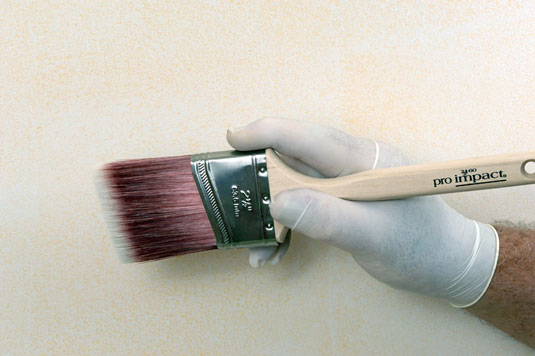To paint like a pro, you have to hold the brush like a pro. Lay the handle of the brush flat over the back of your thumb while holding the ferrule (the metal part that holds the bristles together) between your index and middle finger. The point of a slanted brush should be on the finger side, not the thumb side.

How to hold a Paint Brush The correct way
House painters spend two days on average for painting an average-sized room. That’s how long it takes to prep, prime, and paint correctly. It’s more work, but when you stand back to admire the results, you’ll agree it’s time well spent.
If an errant brushstroke should touch down on the wall, don’t worry—wet paint is pretty easy to clean. If you keep a damp cloth nearby, you can stretch the fabric over a finger and wipe the wet paint off the wall. Just be sure to wad the excess cloth up in your palm to prevent it from touching the wet baseboard.
There are times when even the pros use painter’s tape. When they’re painting against finished surfaces like flooring and woodwork, they’ll often stretch tape across the surface to protect it. However, when it comes to painting walls and trim, they typically forego the tape in lieu of their skills and steady hands.
Most of us can do an okay job of painting a room. But a seasoned professional does a great job. Obviously, pros have more experience than the average homeowner, but they also know techniques and tricks that make them better painters.
To begin, move what you can out of the room. Every painter we spoke with had a horror story about the time he didn’t follow Rule No. 1. Bigger pieces of furniture can sometimes be left covered in the center of larger rooms, but if you are repairing drywall.
Remove door handles, light fixtures, and hardware, and label everything with masking tape. Also, invest in drop cloths. “It’s surprising how well a few drops of paint can cover a floor,” says Mina Boos, of Blue Paint Au Painting and Decorating in Campbelltown. Buy high-quality drop cloths, such as canvas or paper-backed plastic. A note that, paint soaks right through lightweight fabrics and bedsheets. Plastic sheeting works, but it’s very slippery and doesn’t absorb drips.
Sanding not only feathers out chipped paint but also provides “tooth” for the next coat of paint. For glossy trim, use a sanding sponge rather than sandpaper. Sponges mold to the shape of the trim and last longer than paper.
Filling gaps with a paintable acrylic-latex caulk cuts down on drafts and makes your trim look better than new. The secret to using caulk is to cut the tip smaller than you think it should be; too much caulk makes a mess.
Also, instead of using a nail to break the inner seal, use a small wire so you don’t stretch out the nozzle. Also consider buying a dripless caulk gun, which will automatically back off the pressure after each pull on the trigger to prevent unwanted oozing.
Primers aren’t just diluted paint. They’re formulated to establish a solid, even base, seal stains and ensure that the topcoats of paint go on smoothly and bond securely to the surface. Most homeowners use latex primers, but the pros stick to alcohol and alkyd primers because they’ll cover almost anything.
In general, glossier paints are more stain-resistant and scrubbable. But a higher sheen also highlights any imperfections in the wall or in the paint job. “Flat paints are fine for ceilings and formal rooms, but for most of my customers, I recommend an eggshell gloss. It’s good for hallways, kids’ rooms, even kitchens, and baths.
Accidents happen. Keep a cheap sponge brush on hand to blend a patch with the rest of the wall or woodwork. To mimic the look of a roller, simply dab on the paint.
we will get back to you the same day and schedule same day quotation or whenever suits you best.